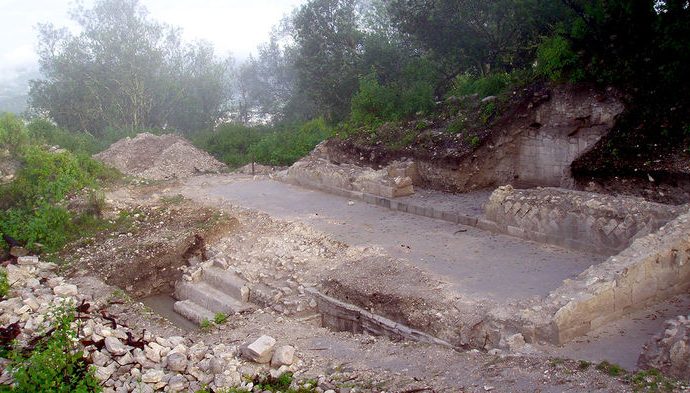The symptoms were unlike anything the doctors of the time had seen.
Victims turned yellow from jaundice, and blood ran from their ears and noses. They had hallucinations and agonizing convulsions. They died in days. Aztecs called it the cocoliztli, meaning pestilence in the local Nahuatl language. “The cocoliztli appeared from almost nowhere. Nobody knew what it was,” says Rodolfo Acuña-Soto, a historical epidemiologist at the National Autonomous University of Mexico in Mexico City.
Even today, nobody knows what exactly was responsible for the epidemic, which first appeared in Mexico, then called New Spain, in the 16th century and killed an estimated 45% of the entire native population. Historical records suggest it was some type of hemorrhagic fever—like Ebola—but DNA evidence published this week suggests the culprit might have been salmonella—a common food-borne illness—brought by European colonizers.
The evidence was tucked in the teeth of 29 skeletons unearthed from the ruins of an ancient city archaeologists call Teposcolula Yucundaa in the Oaxaca region of Mexico. The main inhabitants were Mixtec people, a distinct group from the Aztecs of central Mexico. Twenty-four skeletons came from a cemetery dating to the first cocoliztli outbreak in 1545, and five came from a cemetery roughly 100 years older. Pathogens that ravaged the body at its death can be entombed within the tooth’s inner chamber and detected years later, says Kirsten Bos, a molecular paleobiologist at the Max Planck Institute for the Science of Human History in Jena, Germany, and an author on the study.
Bos and her colleagues drilled into the skeletons’ teeth and extracted DNA from that inner chamber. Once they had sequenced all the DNA, the team began comparing strands against a large database of modern bacterial pathogens. Their analysis matched the DNA fragments to Salmonella enterica, they report in Nature Ecology & Evolution. This type of salmonella, paratyphi C, can cause enteric fever, a serious bacterial infection also known as typhoid or paratyphoid fever. Today, the Centers for Disease Control and Prevention estimates enteric fever-causing salmonella results in more than 21 million cases globally and fewer than 6000 illnesses in the United States every year.
The team found salmonella in 10 of the remains dating to the outbreak, but not in any of the five skeletons predating European contact. Plus, archaeological work from 2017 found the same type of salmonella in an 800-year-old Norwegian skeleton. That helps the argument that Europeans carried the bug to Mexico, potentially through livestock or human carriers. Once in the Americas, the bug would have leached into local food and water sources from feces or vomit from sick individuals, says Hendrik Poinar, an ancient DNA researcher at McMaster University in Hamilton, Canada, who was not involved with the study. “The work is very good. We’ve been hoping for a while to get molecular insight” into the famed cultural, economic, and biological exchange between the New World and the Old World, he says.
It’s harder to tell whether the salmonella alone killed these people, Poinar says. “I’m buying that it likely contributed to this epidemic. Is that what they died of? I’d be careful of saying that.” Perhaps salmonella was simply one of multiple infections that together became deadlier and caused cocoliztli, he says.
Historical descriptions of the cocoliztli certainly don’t sound like salmonella, Acuña-Soto says. “The paper is great. We [now] know there’s an outbreak of salmonella,” he says. “But never in history have I heard of salmonella doing something like cocoliztli with the bleeding, the jaundice, the spread.”
But Bos think salmonella still might be behind the cocoliztli, saying that in order for her team to detect the pathogen, these people must have had “massive” amounts of the bacteria in their blood. “When you get a very advanced bacterial infection, you can get bleeding from orifices and symptoms very similar to a hemorrhagic fever,” she says. “The historical records match a hemorrhagic fever, but we shouldn’t be too dismissive on what biologic agent it really was.”
It’s difficult to say why the cocoliztli was so deadly for the native peoples, but the indigenous population may also have been suffering from malnourishment as a result of a great drought that afflicted the region at the time, Acuña-Soto says.
If the bug wasn’t present in the Americas before European arrival, the locals may have lacked a strong natural immune response to the disease and made them more susceptible. Whatever the pathogen, it swept through the region like a storm. At the time, historian Fray Juan de Torquemada wrote, “In the year 1576, a great mortality and pestilence that lasted for more than a year overcame the Indians … the place we know as New Spain was left almost empty.”
Source: Science Magazine

































Leave a Comment
You must be logged in to post a comment.